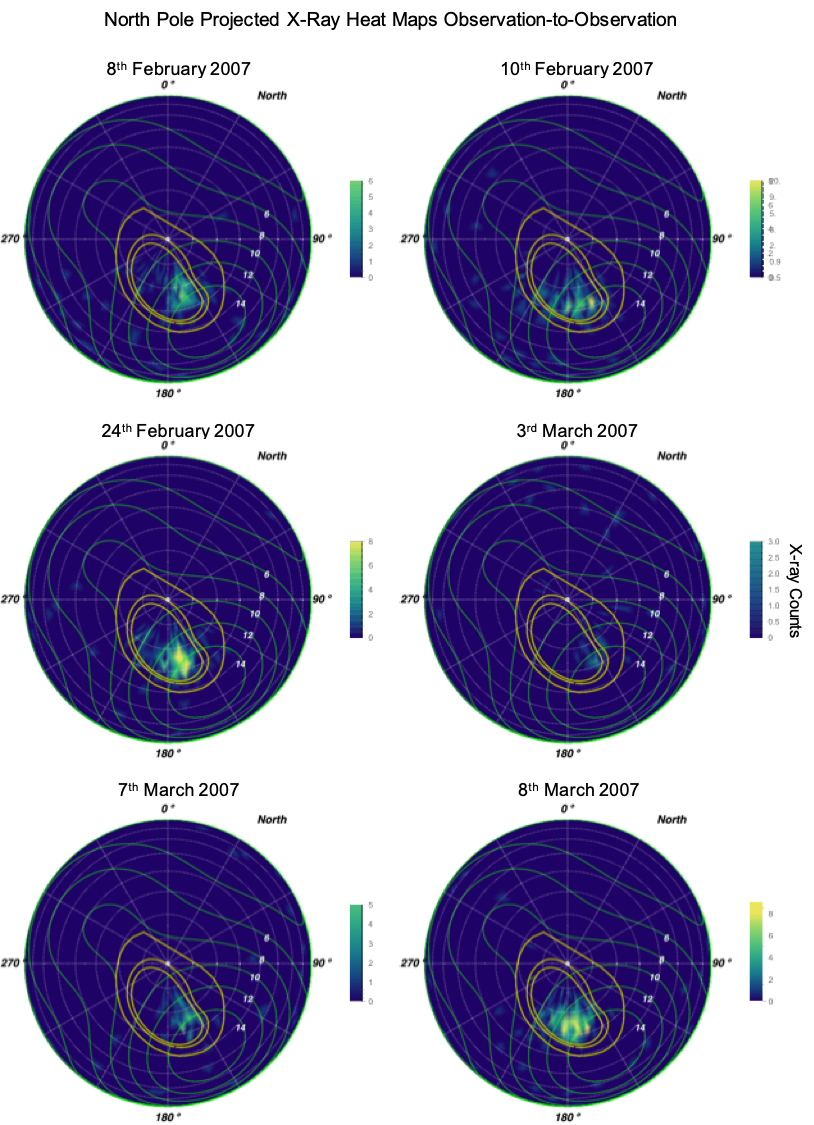MIST
Magnetosphere, Ionosphere and Solar-Terrestrial
Jupiter’s X-ray Emission 2007 Part 1 and Part 2
By William Dunn (Mullard Space Science Laboratory, UCL; The Centre for Planetary Science at UCL/Birkbeck; Harvard‐Smithsonian Center for Astrophysics)
The solar minimum from 2007-2009 was the lowest and longest of the space age. In February 2007, the New Horizons spacecraft was approaching Jupiter measuring the conditions in the solar wind. At this time, a rich multi-instrument observing campaign was conducted, including X-ray, UV and Radio observations. In 2 accepted JGR: Space Physics papers we explore these campaigns, particularly focussing on the X-ray observations.
The first paper concentrates on the X-ray emissions in the context of solar minimum. We explore the spectral and spatial morphologies of Jupiter’s X-rays using the Chandra and XMM-Newton (XMM) observatories. We show that the Jovian equatorial emission varies with solar cycle and may be utilised as a diagnostic of the disk-integrated solar spectrum at a given time.

Figure showing variability in Jupiter’s X-ray aurora as recorded by Chandra ACIS during the 2007 campaign. Each plot shows a projection on Jupiter's North pole of the X-ray aurora. The logarithmic color bar indicates the number of X-rays in bins of 3 degree by 3 degree of S3 latitude-longitude. Dashed grey lines of longitude radiate from the pole, increasing clockwise in increments of 30 degree from 0 degree at the top. Concentric grey circles outward from the pole represent lines of latitude in increments of 10 degree. Thin green contours with white text labels indicate the VIP4 [Connerney et al. 1998] model magnetic field strength in Gauss. Thick gold contours show the magnetic field ionospheric footprints of field lines intersecting the Jovigraphic equator at 5.9 RJ (Io's orbit), 15 RJ and 45 RJ [Grodent et al. 2008; Vogt et al. 2015] from equator to pole respectively.
The second paper compares the UV, Radio and X-ray auroral emissions in the context of the solar wind conditions, identifying shared behaviours between the emissions. Generally, we find that Jupiter’s X-ray aurora is best fit by ion lines from precipitating magnetospheric plasma, but during some magnetospheric expansions the spectrum is very different. At these times, the spectral models require the inclusion of a precipitating solar wind ion population, suggesting that additional solar wind ions gain access to the outer magnetosphere or directly to the pole during magnetospheric expansions. During these expansions we also observe a new type of X-ray aurora, which coexists with the other aurorae. We label this new aurora as ‘flickering X-ray aurora’ based on its temporal behaviour.
The papers lay important groundwork in X-ray aurora spectral modelling and in attempting to understand the unification of the different multi-waveband auroral emissions and their relationship to solar wind conditions.
For more details see:
Dunn, W. R. et al. Jupiter’s X-rays 2007 Part 1: Jupiter’s X-ray Emission During Solar Minimum. J. Geophys. Res. Sp. Phys. https://doi.org/10.1029/2019JA027219
Dunn, W. R. et al. Jupiter’s X-ray Emission 2007 Part 2: Comparisons with UV and Radio Emissions and In-Situ Solar Wind Measurements. J. Geophys. Res. Sp. Phys. https://doi.org/10.1029/2019JA027222